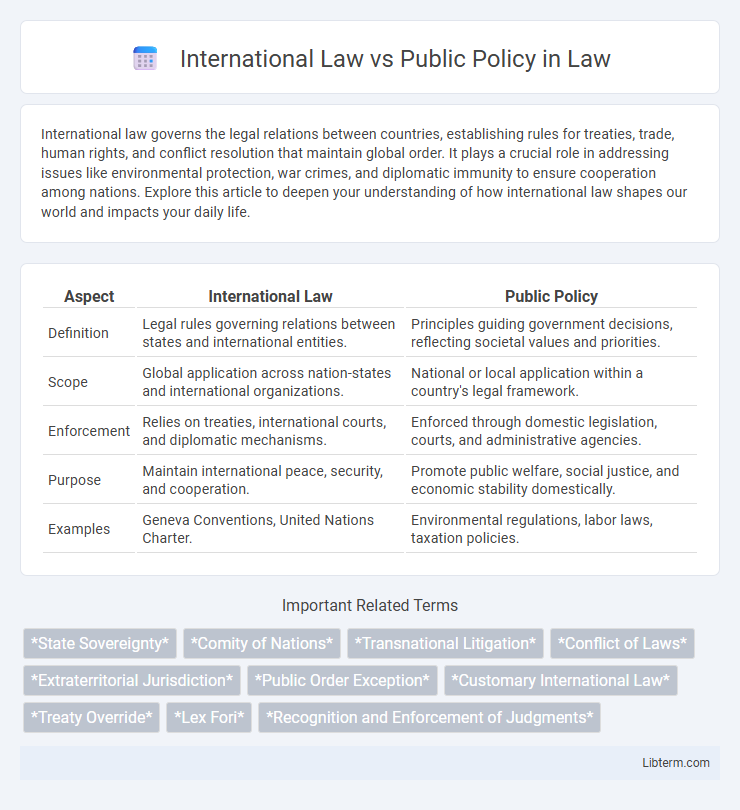International law governs the legal relations between countries, establishing rules for treaties, trade, human rights, and conflict resolution that maintain global order. It plays a crucial role in addressing issues like environmental protection, war crimes, and diplomatic immunity to ensure cooperation among nations. Explore this article to deepen your understanding of how international law shapes our world and impacts your daily life.
Table of Comparison
| Aspect | International Law | Public Policy |
|---|---|---|
| Definition | Legal rules governing relations between states and international entities. | Principles guiding government decisions, reflecting societal values and priorities. |
| Scope | Global application across nation-states and international organizations. | National or local application within a country's legal framework. |
| Enforcement | Relies on treaties, international courts, and diplomatic mechanisms. | Enforced through domestic legislation, courts, and administrative agencies. |
| Purpose | Maintain international peace, security, and cooperation. | Promote public welfare, social justice, and economic stability domestically. |
| Examples | Geneva Conventions, United Nations Charter. | Environmental regulations, labor laws, taxation policies. |
Introduction to International Law and Public Policy
International law governs the legal relations and obligations between sovereign states and international entities, establishing norms such as treaties, customs, and principles recognized globally. Public policy reflects a nation's internal legal framework, representing the collective societal values and principles that guide domestic lawmaking and judicial decisions. Understanding the interaction between international law and domestic public policy is essential for resolving conflicts where international obligations may challenge national interests and legal standards.
Defining International Law: Scope and Principles
International law governs the legal relations between sovereign states and international entities, encompassing treaties, customs, and general principles recognized by the global community. Its scope includes areas such as human rights, armed conflict regulation, and environmental protection, guided by principles like state sovereignty, non-intervention, and pacta sunt servanda (agreements must be kept). Public policy serves as a domestic legal concept reflecting a nation's fundamental values and interests, often limiting the application or enforcement of international law when conflicts arise with core national regulations or morals.
Understanding Public Policy: Domestic and Global Perspectives
Public policy encompasses the principles, regulations, and actions adopted by governments to address societal issues within their jurisdictions, reflecting domestic priorities and socio-economic conditions. In the global context, public policy interacts with international law by shaping how states comply with treaties, human rights standards, and global governance frameworks while balancing national interests. Understanding this dynamic helps clarify the tension between sovereign policy decisions and international legal obligations across diverse political and cultural environments.
Key Differences Between International Law and Public Policy
International law consists of binding rules and principles governing relations between sovereign states and international entities, enforced through treaties, conventions, and customary practices. Public policy refers to the internal guidelines and laws created by governments to regulate behavior within their own jurisdiction, shaped by social values, economic goals, and political priorities. Key differences include international law's global scope and enforceability across borders, contrasted with public policy's domestic focus and variability according to a nation's legal and cultural context.
Intersection of International Law and State Public Policy
The intersection of international law and state public policy often reveals conflicts where international obligations challenge domestic priorities and legal frameworks. States navigate this tension by selectively incorporating international treaties into national legislation while safeguarding sovereignty and core public interests. Understanding how courts balance these competing demands is crucial for harmonizing global legal standards with localized governance and policy objectives.
Conflict Resolution: When Public Policy Contradicts International Law
Conflict resolution between international law and public policy arises when national regulations or practices directly contradict international legal obligations, creating legal and diplomatic tensions. Courts and international tribunals often employ principles such as pacta sunt servanda and the doctrine of state sovereignty to navigate these conflicts while seeking equitable solutions. Effective resolution requires balancing respect for international commitments with protecting vital domestic interests, frequently through negotiated treaties or judicial interpretation.
Case Studies: International Treaties versus National Interests
International law often confronts challenges when national interests contradict treaty obligations, as seen in the U.S. withdrawal from the Paris Agreement, highlighting conflict between global environmental commitments and domestic energy policies. The South China Sea disputes exemplify how international maritime treaties clash with national sovereignty claims, emphasizing the tension between legal frameworks and strategic interests. These cases reveal the complexity of enforcing international law when public policy prioritizes security, economic growth, or political autonomy.
The Role of Sovereignty in Shaping Public Policy
Sovereignty fundamentally influences public policy by asserting a nation's authority to govern within its borders without external interference, thereby shaping how international law is interpreted and applied domestically. Governments prioritize sovereignty to maintain control over legal frameworks, economic regulations, and social policies, often leading to selective adherence or resistance to international legal obligations. The tension between respecting state sovereignty and fulfilling international law commitments creates dynamic challenges for policymakers balancing national interests with global cooperation.
Challenges in Harmonizing International Law and Public Policy
Challenges in harmonizing international law and public policy arise from differing national interests, cultural values, and legal traditions that create conflicts in interpretation and application. Sovereignty concerns often impede uniform implementation of international treaties, while public policy priorities vary significantly between states, leading to inconsistent enforcement and compliance. These divergences complicate the creation of universally accepted legal frameworks and hinder effective global governance.
Future Trends: Evolving Dynamics between International Law and Public Policy
Future trends in the evolving dynamics between international law and public policy reveal an increasing interplay as globalization intensifies cross-border challenges such as climate change, human rights, and cybersecurity. States are progressively integrating international legal frameworks into domestic policy-making to enhance regulatory coherence and address transnational issues effectively. The rise of multinational institutions and digital governance mechanisms signifies a shift towards more collaborative, adaptive legal approaches shaping public policy worldwide.
International Law Infographic

 libterm.com
libterm.com